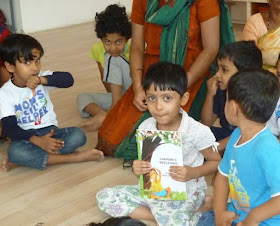 Imagine: How Creativity Works, by Jonah Lehrer
Imagine: How Creativity Works, by Jonah LehrerAnecdote-heavy travels through the world of creativity, and its practitioners
(Amazon, Flipkart, Infibeam, IndiaPlaza)

This is an enjoyable, surprising in places, though somewhat anecdote-heavy, travel through the world of creativity and a look into what drives the spark and sustains the fire of creativity in people who are masters of creativity in their disciplines.
If you read Jonah Lehrer's, the author, articles in Wired magazine, you will know two things. First, he writes exceedingly well, a craft honed no-doubt over thousands of hours of focused practice, and secondly, his writings are very much into understanding how the mind works and how we decide, incidentally the title of his previous monster blockbuster bestseller, How We Decide. This book is no different - written with a flowing felicity. Its focus is on a specific capability of the brain - creativity.
Whether it is designing a better mop, writing songs (Bob Dylan), becoming a renowned playwright (Shakespeare, of all people), creating movies (Pixar), performing as a soloist (Yo-Yo Ma), creativity works in somewhat surprising yet also reassuringly familiar ways. The single biggest rule of creativity is that it is open to almost everyone. Even people traditionally bucketed as "handicapped" or "disabled" (autistic people for instance) are blessed with a brain that is differently wired from others, and therefore better adept at creativity in specific areas.
Drugs too can help - yes, I would call that a tad controversial, but the evidence does lend itself to the supposition that certain drugs can help free the mind from the shackles of conformity and set it on a path of creativity. And not just drugs, even stimulants like tea or coffee can help. "Paul Edros... is said to have remarked that a 'mathematician is a machine for turning coffee into theorems.'" Actual drugs work by changing the way the brain works. "Amphetamines act primarily on a network of neurons that use dopamine, a neurotransmitter, to communicate with one another. ... the drug dramatically increases the amount of dopamine in the synapses, which are the spaces between the cells." However, this creativity needs to be followed up by long, long hours of drudgery, so to say, where this spark of creativity is refined, again and again, and then some more, till it reaches the pinnacle of perfection. "If you are doing it right, it's going to feel like work." or "In fact, there is evidence suggesting that the ability to relentlessly focus on a creative problem can actually make us miserable." To wit, if the next time you complain to your boss that he is making your life miserable, he may well respond it's all to make you creative!
Day-dreaming is for the creative types too - disciplined daydreaming, if ever there was a conundrum. Working in teams can dramatically, and provably so, increase productivity and creativity. The example of Pixar is used, and describes some extreme steps like moving the bathrooms at the Pixar team's office into the atrium, which meant, in Steve Jobs' words, "Everybody has to run into each other." Did it help? Well, consider Pixar's track record - every single movie of theirs has been a commercial and artistic success. There is also the story of how Toy Story 2, less than a year before its release, was "Well, it's okay". It took radical steps, like getting everyone close together, physically, and long, long hours of debate and criticism and debate, to get the movie out in the form everyone saw it. Did it take a toll on people? Yes, severe. Tradeoffs I suppose.
Lastly, cities are often derided as agglomerations of decay, pollution, crime, corruption, and moral decay. And certainly, cities and their denizens work overtime to fulfill that promise. However, cities also act as a multiplier when it comes to creativity. Again, provably so. From the times of Shakespeare, or even much before that, densely populated regions have acted as creativity catalysts.
To summarize, this book can be read as a loosely connected collection of essays on creativity. Each chapter focuses on a particular aspect of creativity, held together by scientific evidence and anecdotes. I would strongly recommend this book to one and all.
These are the author's previous novels:
Some other books I would recommend:
Brain Rules for Baby: How to Raise a Smart and Happy Child from Zero to Five, by John Medina
Brain Rules: 12 Principles for Surviving and Thriving at Work, Home, and School
(Flipkart.com link, All results, Kindle
The Upside of Irrationality: The Unexpected Benefits of Defying Logic at Work and at Home


Kindle Excerpt:
© 2012, Abhinav Agarwal. All rights reserved.






























